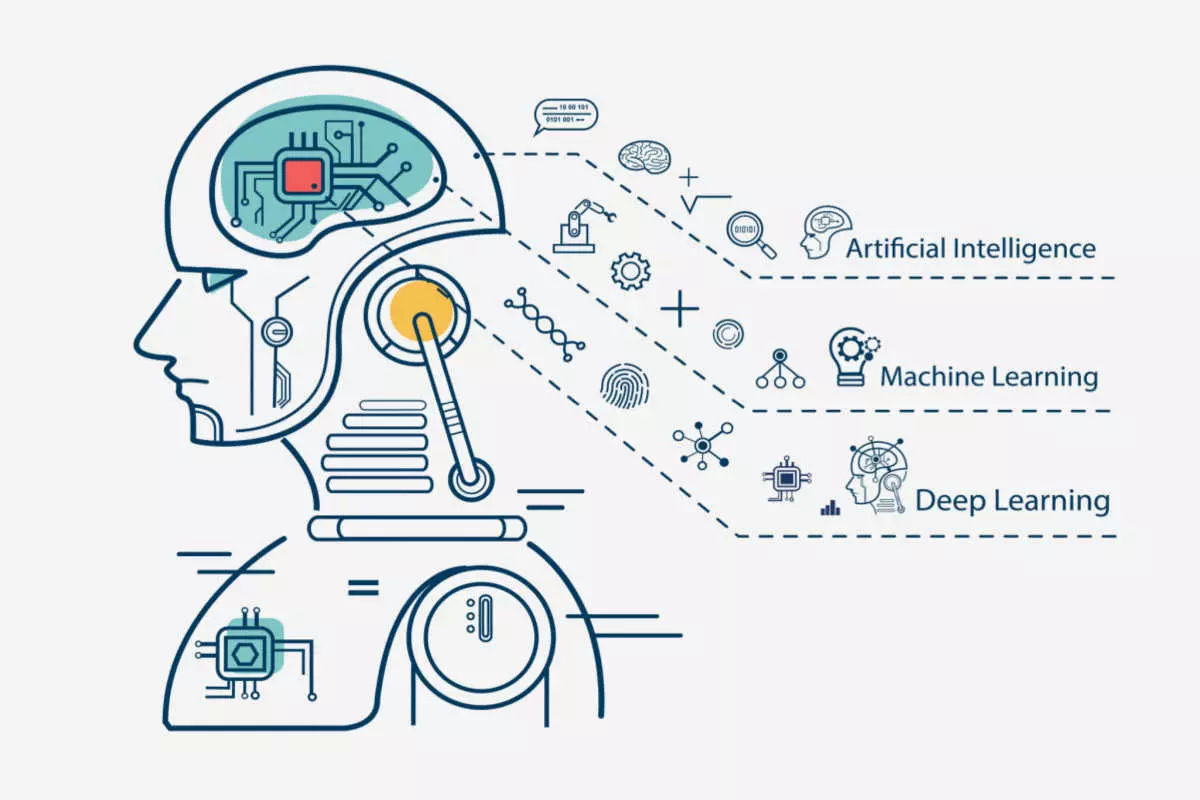The Future of AI Infographics
Artificial intelligence (AI) helps designers create infographics faster and at a lower cost due to the increased speed and efficiency it offers.
The future of AI infographics relies on augmented reality (AR) and virtual reality (VR) and the blurring lines between big data and graphic design.

Increasingly, real-time data analyses based on AI and machine learning (ML) will help design more accurate, in-depth, predictive, interactive, and attractive infographics quickly and easily.
When the first infographics were introduced in the late 1700s, no one thought they’d become so popular in the future. Those infographics represented charts of wheat prices and labor wages created by Scottish engineer and political economist William Playfair.
Infographics are visual representations of information used to depict and explain data more clearly and concisely. And today, when global data creation is forecast to reach over 180 zettabytes by 2025, the need for infographics is more vital than ever.
What about AI infographics? And how will artificial intelligence, the main driver of technologies, affect the graphic design future?
What Is an Infographic and Why Is It Important?
Think of an infographic as a collection of imagery or data visualizations. It can be a chart or a graph that uses minimal text to provide an easy-to-understand overview of a topic. And that’s why the word “infographic” is comprised of the words “information” and “graphic.”
Infographics are now the fourth most-used type of content marketing. Specifically, an infographic image helps boost website traffic by up to 12%. In addition, 65% of brands turn to infographics for marketing purposes.
Specifically, marketers use them to educate their audience about new products or services. Additionally, infographics help enhance marketing content through eye-catching visual elements.
Benefits of Infographics
Humans are visual beings. And infographics serve as a valuable tool for visual communication. Did you know that image-processing time is 60,000 times faster in the brain compared to text? Moreover, 90% of the information the brain receives is visual.
That’s why people prefer an infographic over a lengthy text. So, it’s no surprise that, on average, people only skim 20% of a website text when visiting a site, according to web-usability consultant and human-computer interaction researcher Jakob Nielsen.
Thus, the more visually unique and creative infographics are, the more effectively they can grab people’s attention. Notably, the more accurate infographic data is, the quicker the reader can understand and remember it.
So, what are the benefits of infographics? Notably, infographics:
- Deliver a quick overview of a topic.
- Summarize the long text.
- Compare and contrast several options.
- Effectively display research outcomes or survey data.
- Clearly explain complex information or a process and make it easy to digest.
- Raise awareness about a topic and boost its engagement and shareability.
- Build brand awareness and increase brand credibility.
- Improve decision-making.
Importantly, color plays a unique role in infographic creation. After all, color raises readers’ attention spans and recall by 82% and gains readership by 80%. That’s where color psychology steps in to help pick the right color for a business. For instance, blue is the color of security, strength, wisdom, and trust.
What Are the Different Types of Infographics
Infographics are often used to display statistics, maps and hierarchies, and changes or comparisons in data, time, and place.
For instance, companies send a visually catchy newsletter with an infographic to deliver news and tell subscribers about a new product or service. Additionally, infographics help educators and training personnel make content more memorable for learners.
Here are the most common types of infographics:
- Statistical: shows specific data points or statistics.
- Informational: summarizes the main points of a complex topic.
- Timeline: shows the different steps of event planning, a topic storyline, or a timeline of essential milestones a company has reached.
- Process or Flowchart: breaks down the main components of a process, event, or project.
- Comparison: compares different products or services and highlights the positives and negatives of a viewpoint.
- List: summarizes or lists tips or main points on a topic.
- Interactive: uses interactive elements, such as animation effects, to make the reader click and scroll.
- Map: presents information on business locations in different geographic areas or provides a quick rundown of demographics.
Infographic Design and Its Growth
Colors and graphics represent the visual side of infographics, and design conveys the emotional side behind its message. That’s why people aren’t likely to open a plain email and read it, as it’s boring.
The future of infographic design is associated with artificial intelligence growth. Specifically, the global AI market size was $93.5 billion in 2021. Moreover, according to Grand View Research, Inc., its compound annual growth rate (CAGR) is forecasted to be 38.1% from 2022 to 2030.
Today, data-driven choices play a decisive role in boosting a company’s competitiveness. And AI has unlocked a new world of opportunities in this regard, such as AI infographics for designers. Specifically, thanks to automation, AI helps designers:
- Create infographics more efficiently and quickly.
- Make their job more manageable and cost-effective.
- Accelerate the process of creating the same graphics in multiple languages.
- Make complex decision-making more efficient.
- Focus on higher-level work.
- Boost productivity.
For instance, Nutella used an AI algorithm to generate millions of unique packaging designs based on data from dozens of patterns and colors. As a result, all of those jars were sold in a month.
The Future of Infographics: Will AI Take Over Design?
AI will increasingly act as a creative collaborator and tool to help designers succeed in the ever-evolving world of design.
According to Digital Kitchen’s founder and chairman, Paul Matthaeus, storytelling won’t have a clear narrative arc in the future. Specifically, creative writing will fuse with artificial intelligence to help writers create new forms of interactive stories. And that’s where more advanced AI infographics come into play.

The blurring line between machine and human activity continues to open new doors for designers. For instance, smart AI design tools, such as Canva and Visma, allow users to establish a basic design and set a few parameters to generate multiple design alternatives quickly. Then, users pick the best design based on their preferences.
AI Infographics Future
The human brain perceives the world mainly through vision. And a large percentage of the human brain is on the hook for visual processing. People’s love of images is associated with their cognition and ability to pay attention. And images, including AI infographics, grab attention better than plain blocks of text.
Let’s see how artificial intelligence trends, such as AI in content creation and data organization, will impact the graphical representation of data via infographics. Such representation is called data visualization.
- Tighter Connection Between Big Data and Design Teams
Big Data and design teams will work together, preferably physically in the same workspace, to create a message using visual and graphic elements.
Namely, the visualization experience of the future will be about fusing data and design to supercharge innovation, as mentioned in a McKinsey report. Specifically, it’ll be increasingly important to analyze customer data to create more appealing infographics that target audiences better.
- Increased Use of Real-Time Data for Infographics
Cloud computing enables companies to view data in real time from various sources. It uses data storage, servers, databases, networking, and software over the Internet. For example, Azure and Google are cloud computing services.
As a result, they get a clear picture of current business operations and react much faster to them. And more accurate data that is available in real-time and in larger amounts will increasingly help create more in-depth and up-to-date infographics.
- Increased Use of AI Image Generation Software
Innovative AI systems, such as Jasper Art, DALL-E 2, or Canva AI Art Generator, use ML to create images from text. In this case, AI helps understand words and convert them to unique images. Increasingly, AI infographic design will rely on this software.
Specifically, instead of spending hours hunting for stock photos or trying to photoshop them, users can tell Jasper what they want. And the software will create unique art in seconds based on those parameters.
- More Impressive Images for Infographics
AI will drastically simplify the process of restoring pictures and improving resolution. And this is thanks to AI-based image enhancement tools such as Vance AI and Upscalepics.
Specifically, these tools quickly make pixelated and blurry images high-quality, clean, and sharp. In addition, they require seconds to fix poor lighting, contrast, and color.
- AI Infographics for Personalized Experience
Big data analysis is shaping the future of infographics. And designers will increasingly implement it to retain customers and grow business profits.
Specifically, AI uses high volumes of data to help companies better target their audience’s likes and dislikes. As a result, they create infographics based on their personalized experiences, which helps build brand loyalty and tighter connections with customers.
- AI Infographics Based on Speedier Predictive Forecasting
Designers and engineers use artificial intelligence to develop intelligent algorithms that solve complex problems. For example, AI helps quickly and easily build millions of design variations.
And this is made possible through data analyses, which enables predictive forecasting. The latter is AI-based estimation based on historical data to predict future events.
Increasingly, AI will help quickly analyze vast amounts of data and suggest design adjustments for infographics. And designers can then approve adjustments based on that data.
- Infographic Design Based on Self-Learning AI Algorithms
These are programmed to make creative decisions on their own. Increasingly, designers will train AI tools to create models based on their preferences. That’s where deep reinforcement learning (deep RL) comes into play to help design AI infographics.
Deep RL is a relatively new technique. It’s a category of ML and AI where intelligent machines can learn from their actions, similar to how humans learn from their experiences.
Conclusion
AI infographics take information and wrap it up in a graph. Thanks to deeper data analyses, they help convey complex information more simply and accurately. As a result, the reader understands that information more quickly and remembers it better.
Increasingly, the future of an AI infographic illustration will be associated with technological advances such as self-learning AI algorithms and augmented and virtual realities.
Try our real-time predictive modeling engine and create your first custom model in five minutes – no coding necessary!
- Fully operational AI with automated model building and deployment
- Data preprocessing and analysis tools
- Custom modeling solutions
- Actionable analytics
- A personalized approach to real-time decision making



